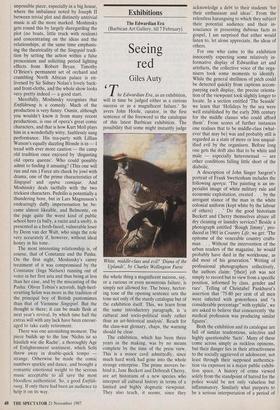Exhibitions
The Edwardian Era (Barbican Art Gallery, till 7 February)
Seeing red
Giles Auty
The Edwardian Era, as an exhibition, will in time be judged either as a curious success or as a magnificent failure.' So avers John Hoole, curator, in the first sentence of the foreword to the catalogue of this latest Barbican exhibition. The possibility that some might instantly judge White, middle-class and evil? 'Diana of the Uplands', by Charles Wellington Furse the whole thing a magnificent success, say, or a curious or even monstrous failure, is simply not allowed for. The bossy, hector- ing tone of the opening sentence sets the tone not only of the sturdy catalogue but of the exhibition itself. This, we learn from the same introductory paragraph, is 'a cultural and socio-political study rather than an art-historical analysis'. Reach for the class-war glossary, chaps, the warning should be clear.
The exhibition, which has been three years in the making, was by no means complete by the time of the press view. This is a minor cavil admittedly, since much hard work had gone into the whole strange enterprise. The prime movers be- hind it, Jane Beckett and Deborah Cherry, are art historians of a new species who interpret all cultural history in terms of a limited and highly dogmatic viewpoint. They also teach, it seems, since they acknowledge a debt to their students 'for their enthusiasm and ideas'. From the relentless haranguing to which they subject their potential audience and their in- souciance in presenting dubious facts as gospel, I am surprised that either would listen to, let alone appreciate, the ideas of others.
For one who came to the exhibition innocently expecting some relatively in- formative display of Edwardian art and artefacts, the collective voice of the orga- nisers took some moments to identify. While the general shrillness of pitch could be detected quickly from captions accom- panying each display, the precise orienta- tion of the viewpoint took slightly longer to locate. In a section entitled 'The Seaside' we learn that 'Holidays by the sea were well established by the early 20th century for the middle classes who could afford them'. From scores of further instances one realises that to be middle-class (what- ever that may be) was and probably still is regarded as a state of more or less unqual- ified evil by the organisers. Before long one gets the drift also that to be white and male — especially heterosexual — are other conditions falling little short of the diabolic.
A description of John Singer Sargent's portrait of Frank Swettenham includes the following apergu: 'The painting is an im- perialist image of white military rule and economic exploitation, created. . . by the arrogant stance of the man in the white colonial uniform (kept white by the labour of others) . . .' Do the good historians Beckett and Cherry themselves abjure all dry cleaning or laundry services? Beside a photograph entitled 'Rough Jimmy', pro- duced in 1901 in Country Life, we get: 'The epitome of the venerable country crafts- man . . . Without the intervention of the urban readers of the magazine, he would probably have died in the workhouse, as did most of his generation.' Writing of professional photographers collectively, the authors claim: '[their] job was not simply to record but to view from a specific position, informed by class, gender and race'. Telling of Christabel Pankhurst's assertion that '75-80 per cent of all men were infected with gonorrhoea and "a considerable percentage" with syphilis', we are asked to believe that concurrently 'the medical profession was producing similar figures'.
Both the exhibition and its catalogue are full of similar tendentious, selective and highly questionable 'facts'. Many of these come across simply as reckless opinions, but their danger lies in their attractiveness to the socially aggrieved or adolescent, not least through their supposed authentica- tion via exposure in a major public exhibi- tion space. A history of crime viewed solely from the standpoint of hatred for the police would be not only valueless but inflammatory. Similarly what purports to be a serious interpretation of a period of this country's history, yet based largely on loathing for the white, middle-class male, is quite the wrong fare to find within the neutral and dignifying walls of a public art gallery.
Few who bother to read or think for themselves understand Edward VII's reign solely in the light of nostalgia induced by glossy period dramas on television. The era, like all others in human history, was an age of ills and injustices. A more balanced guide to the nature of these may be found in the autobiographies, memoirs and novels of the period. When younger I had first-hand access to the reminiscences of grandparents, aunts and uncles. My late mother was a tiny child in the Edwardian period. One of her major recollections was of the terror induced in infants in perambu- lators by bolting horses. The Barbican exhibition misrepresents seriously by sug- gesting that the priorities and obsessions of the era were those which envenom the organising duo: class, race and sexual warfare.
The exhibition comprises 300 paintings and hundreds of photographs, together with architectural drawings, political post- ers and cartoons, suffragette and trade union banners. There is also a replica of Bleriot's Channel-hopping aeroplane, an early bicycle and a 1904 Vauxhall. Authen- ticity ends with vintage historical detail. The real ambience is Eighties Camden.



































































 Previous page
Previous page